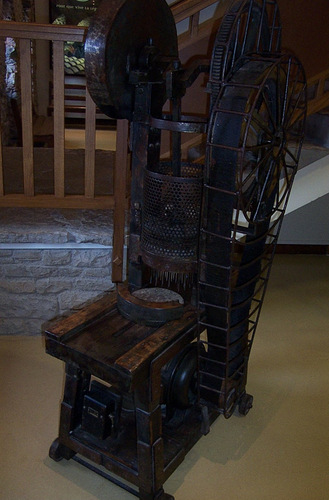 The village of Roquefort, France is located on the southern tip of the high Massif Central plateau about 100 miles from the Mediterranean Sea, and it is built into the cliffs containing the caves that “invented” blue cheese. Natural air currents vent these caves (called “fleurines“) and carry the naturally occurring Penicillium roqueforti spores through them, as well as keep the caves at a constant temperature and humidity. As part of the AOC definition of “Roquefort” cheese, all cheeses with that name must spend at least two weeks in these caves. This means that 24 hours a day trailer trucks full of young cheese are brought to the caves while each cheese that has already been two weeks in the caves are loaded back onto the same trailers and taken away to cold storage for final aging. Below are some pictures of the village, as well as of an antique cheese piercing machine that looks more like a medieval torture device (which is apt because long ago the Catholic Church purged non-believers from this region through a reign of torture and terror).
The village of Roquefort, France is located on the southern tip of the high Massif Central plateau about 100 miles from the Mediterranean Sea, and it is built into the cliffs containing the caves that “invented” blue cheese. Natural air currents vent these caves (called “fleurines“) and carry the naturally occurring Penicillium roqueforti spores through them, as well as keep the caves at a constant temperature and humidity. As part of the AOC definition of “Roquefort” cheese, all cheeses with that name must spend at least two weeks in these caves. This means that 24 hours a day trailer trucks full of young cheese are brought to the caves while each cheese that has already been two weeks in the caves are loaded back onto the same trailers and taken away to cold storage for final aging. Below are some pictures of the village, as well as of an antique cheese piercing machine that looks more like a medieval torture device (which is apt because long ago the Catholic Church purged non-believers from this region through a reign of torture and terror).

